- Sponsored -
Sharad Navratri 2019: Date, Time, Vrat, Significance and Colours
Sharad Navratri the Nine Nights of Durga Worship: Date, Significance, Time and other things
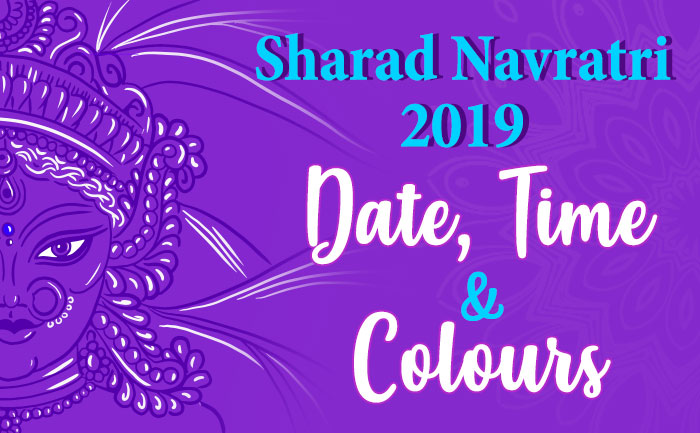
Sharad Navratri or Maha Navratri is just around the corner and it is one of the most awaited festivals of the year in the country. This festival signifies the faith and belief of the people in Goddess Durga and her nine avatars. It is believed that the Goddess descends from heaven to earth and bestows blessings to her devotees. it signifies the victory of peace, goodwill and dharma over evil.
- Sponsored -
Sharad Navratri falls in the Ashwin Lunar month during Sharad Ritu as per Hindu calendar. The name Sharad Navratri is derived from the Sharad Ritu.Happy Navratri Wishes & Song
Sharad Navratri is celebrated in different states of India in different ways. From Maharashtra, Gujarat, Rajasthan, Punjab, West Bengal to Odisha and Bihar. While they worship the same deity, some rituals may vary. Navratri is also celebrated by the migrated Hindu population in, Malaysia, Singapore and Thailand, Trinidad and UK and at all the places around the world, with significant Hindu Diaspora.
Here is all you need to know about the festival Sharad Navratri 2019 :

Types Of Navratri:
Navratri signifies Navsarjan, Nav-Shakti and Nav-Durga. The number 9 indicates Shakti – the power and energy which creates the whole universe. There are four types of Navratri which are celebrated 4 times in a year. But only two of them: Chaitra and Sharad Navratri is celebrated by most.
1. Sharad Navratri, celebrated during Shukla Paksha of Ashwin month, i.e. between September and October month.
2. Chaitra or Vasant Navratri, which is celebrated during Shukla Paksh of Chaitra month, i.e. between March and April month. The beginning of this Navratri also marks the starting of the New Year as per Hindu lunar calendar.
3. The Ashad Navratri & Magha Navratri
These two are also known as Gupt Navratri. The devotees usually perform special rituals to attain Siddhi. These two are for people who practice the occult.
Navratri Festival Story:
There are many stories about Navratri Festival but two of them are quite popular.
1. It is about Lord Rama and how he won the battle against Ravana. Lord Rama was a huge worshipper of Devi Bhagwati. Before battling with Ravana he had devoted himself into the worship of the DEVI for nine days. On a ninth day he was blessed by Devi Bhagwati and on the tenth day, Lord Rama killed Dashanana. Since then, different forms of Devi Bhagwati are venerated for nine days straight and Vijaya Dashami is then observed on the tenth day.
2. The second story is all about the Asura Mahishasura. As per the Markandeya Puran, Demon King Mahishasura was granted the power of immortality. He soon started misusing it and spreading his terror far and wide. The gods in Swarga Lok appealed to Lord Shiva for a solution to get rid of this demon. To protect the three worlds the trinity Brahma, Vishnu and Shiva united their powers and created a female warrior known as Adishakti Durga. Mahishasura was fascinated and totally mesmerized by the divine beauty of Goddess Durga and approached her with the intention of marriage. The goddess agreed to marry Mahishasura but put forth a condition that he will have to defeat her in a battle. The proud Mahishasura agreed immediately! The battle continued for nine nights and at the end of the 9th night, Goddess Durga beheaded Mahishasura. So Goddess Durga is also known as Mahishasur Mardini. Whereas, the 10th day was named as Vijaya Dashmi. Vijaya Dashmi usually falls 10 days prior to Diwali.
Nine forms of Goddess Shakti:

- Maa Shailputri,
- Maa Brahmacharini
- Maa Chandrakanta
- Maa Kushmanda
- Maa Skandmata
- Maa Katyayani
- Maa Kaalratri
- Maa Mahagauri
- Maa Siddhidatri
When is Navratri 2019?
This year the Sharad Navratri begins from September 29 and ends by October 7, 2019. October 8 will be celebrated as Dussehra.
Sharad Navratri 2019 Dates:
Day 1(29th September): The first day belongs to the Goddess Shailputri, the daughter of the Himalayas. She is a form of Shakti and the companion of Lord Shiva. Worshipping her can eliminate all the bad effects of the Moon. Mantra to recite to please the Goddess is ॐ देवी शैलपुत्र्यै नमः॥
Day 2(30th September):- The second day is of Goddess Brahmacharini. She bestows the person with happiness, peace, and prosperity. Worshipping her can eliminate all the bad effects of planet Mars. Mantra to recite is ॐ देवी ब्रह्मचारिण्यै नमः॥
Day 3(1st October): The third day is of Goddess Chandrakanta. This Goddess gives courage and valor to the worshippers. Worshipping her can reduce the ill effects of the planet Venus. Chant this mantra to please her ॐ देवी चन्द्रघण्टायै नमः॥
Day 4(2nd October): The fourth day belongs to the Goddess Khushmanda Mata. She bestows health, wealth, and strength. Worshipping her can eliminate all the ill effects of the Astrological planet Sun. Mantra to recite is ॐ देवी कूष्माण्डायै नमः
Day 5(3rd October): The fifth day belongs to the Goddess Skandmata. She symbolizes power and prosperity. Worshipping her removes the ill effects of the planet Mercury. Mantra for pleasing her is ॐ देवी स्कन्दमातायै नमः॥
Day 6(4th October): The sixth day belongs to the Goddess Katyayani Mata. She got this beautiful name because Rishi Katyayana was the first one to worship her. Worshipping her helps in rectifying the ill effects of the planet Jupiter. Chant this mantra ॐ देवी कात्यायन्यै नमः॥
Day 7(5th October): The seventh day belongs to the Goddess Kalratri Mata. She is considered as the destroyer of darkness. Worshipping her helps in pacifying the ill effects of the planet Saturn. Mantra to please her is ॐ देवी कालरात्र्यै नमः॥
Day 8(6th October): The eight-day belongs to the Goddess Maa Mahagauri, who is known for fulfilling all the wishes of her devotees. Worshipping her helps in pacifying the ill effects of the planet Rahu. Recite this mantra for her ॐ देवी महागौर्यै नमः॥
Day 9(7th October): The ninth day belongs to the Goddess Siddhidatri Mata. This goddess is known for removing ignorance and enhances knowledge to realize eternal power. Worshipping her helps in pacifying the ill effects of the planet Ketu. One can chant this Mantra for Goddess Siddhidatri ॐ देवी सिद्धिदात्र्यै नमः॥
Day 10(8th October): The Tenth day of Sharad Navratri is Vijay Dashmi or Dussehra. This day is celebrated to remark the victory of good over evil because, on this day, Lord Rama killed Ravan.
Colours for Navratri:
Day 1 of Navratri 2019: Colour – Orange
Day 2 of Navratri 2019: Colour – White
Day 3 of Navratri 2019: Colour – Red
Day 4 of Navratri 2019: Colour – Royal Blue
Day 5 of Navratri 2019: Colour – Yellow
Day 6 of Navratri 2019: Colour – Green
Day 7 of Navratri 2019: Colour – Grey
Day 8 of Navratri 2019: Colour – Purple
Day 9 of Navratri 2019: Colour – Peacock Green
Fasting During Navratri:
Meditation and Fasting is a common practice observed by many during Navratri. During fasting, the foods to be avoided are meat, alcohol, grains, wheat, onions, grains too. You can have fresh fruits, milk, curds, sabudana, makhanas too.
Dates And Muhurat Timings Of Shardiya Maha Navratri 2019:
During this Vikram Samvat year 2075, Maha Navratri will start on Wednesday, 29 September 2019.
1. Ghatasthapana Muhurat:- It is on the 1st day of Navaratri,
Ashwin Shukla Pratipada, Timings:- 06:34 AM to 07:54 AM (morning)
2. Durga Ashtami Puja:- Wednesday, 6 October 2019.
Ashtami Tithi Begins = 09:51 AM on Oct 05, 2019
Ashtami Tithi Ends = 10:54 AM on Oct 06, 2019
3. Vijaya Dashmi Muhurat:-
Durga Puja Visarjan: Saturday, 8 October 2019.
Vijay Muhurat = 02:24 PM to 03:10 PM
Aparahna Puja Time = 01:37 PM to 03:57 PM
Durga Visarjan Time = 06:37 AM to 08:57 AM
Navratri Puja Vidhi:
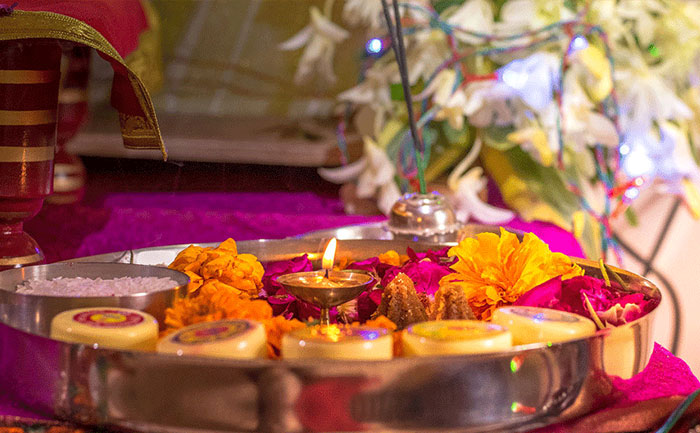
● Wake up early in the morning, take a bath and wear clean clothes.
● Arrange a thali for puja.
● Place the idol or picture of Goddess Durga on a red-coloured cloth.
● Place the clay pot, sow the barley seeds and sprinkle some water every day till Navami.
● In an auspicious muhurat, carry out the process of Ghatasthapana. Fill the urn with Gangajal, and place mango leaves on the top of its mouth. Wrap the neck of the urn with sacred red thread or Mauli, Place the coconut on the top of the urn. Place the urn near or on the clay pot.
● Carry out panchopchar puja of the deities, which includes worshipping with flowers, camphor, incense sticks, scent
and cooked dishes.
● Chant Maa Durga Mantras throughout these nine days and ask for prosperity. Invite her into your house and ask her to grace your house with her presence.
● On the eighth and ninth day, invite nine girls at your house. Wash their feet, offer them a clean and comfortable
seat. Worship them, apply tilak on their forehead and serve them puri, chana and sheera. Then give them gifts.
● On the last day after Durga puja, carry out Ghat Visarjan. Say your prayers, offer flowers and rice to the deities
and remove the Ghata from the altar.
Navratri Celebrated in Different ways in the Different States:
1. Gujarat:
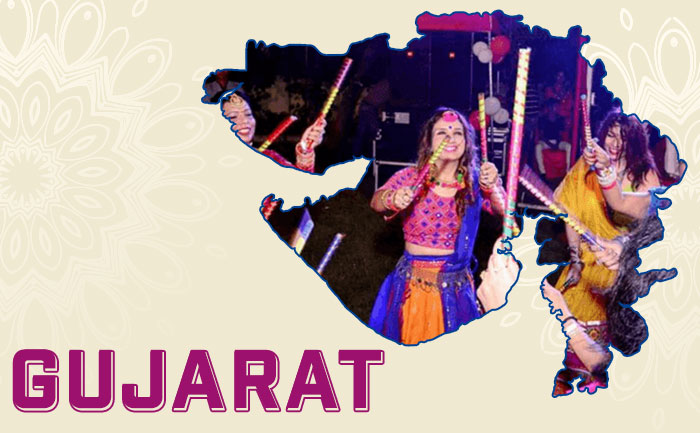
In Gujarat after worshipping the goddess devotees start celebrating it with traditional dances like Garba and Dandiya It takes place around a central lighted lamp, men and women wearing traditional costumes dance in a circle to the accompaniment of devotional songs. The main difference between Garba and Dandiya is that Garba is performed before the worship or Aarti of the Goddess Durga, while Dandiya dance is done after the worship. Another difference is that Dandiya is performed with wooden sticks, while Garba has just the hand and feet movements.
2. Punjab:
Kanya puja is done on the 8th day of the festival before breaking the fast. These girls of prepubescent age are offered puris, chana, halwa, and red scarves. A Jagrata is another special feature to them, where devotional songs are sung in the honour of Goddess and keep awake the whole night.
3. Tamil Nadu:
Idols of various Gods and Goddesses are placed on specially set-up steps. This arrangement is called Golu. The special makeshift staircase ‘Golu’ consists of nine steps symbolizing the nine days of Navratri. Idols of Gods and Goddesses are placed on the stairs that are handed over from generation to generation. Women belonging to the Iyer community invite their married female acquaintances and gift them symbols of marital goodwill- bangles, earrings etc.
4. West Bengal:
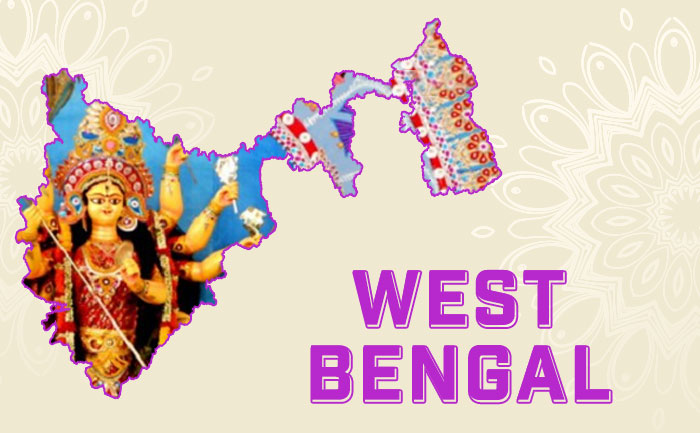
Durga puja is celebrated here on a massive scale. Massive idols of Goddess Durga are installed and huge pandals are set up at various places for devotees to visit and worship. Everyone attends in new clothes. Priests perform rites as per scriptural injunctions for a period of four days. On Dashami, the Goddess is bidden farewell with pomp and show. Assam, too, follows a similar practice of worshipping the goddess.
5. Karnataka(Mysore):
The Mysore district celebration is one of the most famous drawing tourists from far off places. The Mysore palace is lit with thousands of lamps. Decorated elephants are taken out in a procession. The streets are colourfully decorated. The royal deity of Mysore, Chamundi is worshipped on this day. Computers, books, vehicles, kitchen tools are worshipped on the 9th day.
6. Maharastra:

The 10th day is considered auspicious for starting a new business, buying a house, etc. Married women exchange the gesture of ‘Sau Mangalyam’ by putting Haldi and Kumkum onto their foreheads and exchanging gifts. The burning of Ravana’s effigies and dancing to the tunes of Dandiya are quite popular.
7. Andhra Pradesh:
Navratri is celebrated as ‘Bathukamma Panduga’ in Andhra Pradesh. Bathukamma Panduga literally means ‘Come Alive Mother’. Women prepare ‘Bathuka’ which is a beautiful stack of seasonal flowers which often appear like a pot. They have the ritual to position themselves in the centre and sing songs dedicated to Goddess Shakti. After performing the ritual, they float the Bathukkas in lake water.
In UP and Delhi, Ramlila marks the beginning of Navratri. Big stages are set up for the show, which is known to be grand and spectacular. For nine days, Ramlila concludes all aspects of Ramayana and on the tenth day or Dashami, effigies of Ravana are burnt all around the city and country.
8.Himachal Pradesh:
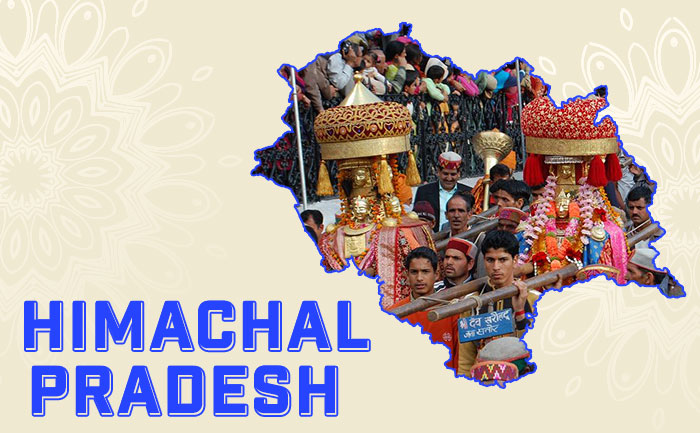
Himachal has many temples devoted to the Devi. So the people of the State celebrate the festival with much enthusiasm. Navratri celebrations in HP start when the rest of India comes close to winding up the worship. At the Dhalpur Maidan in Kully Valley, Lord Raghunath (Rama) is ritually worshipped along with other deities throughout the nine-day-long fest. The tenth day of the festival is called Kullu Dussehra.
Here’s wishing you all a Happy Navratri 2019!
Also Read: Ganesh Chaturthi 2019: Top 7 Bollywood Songs Which Will Make You Go ‘Ganpati Bappa Morya’
- Sponsored -
